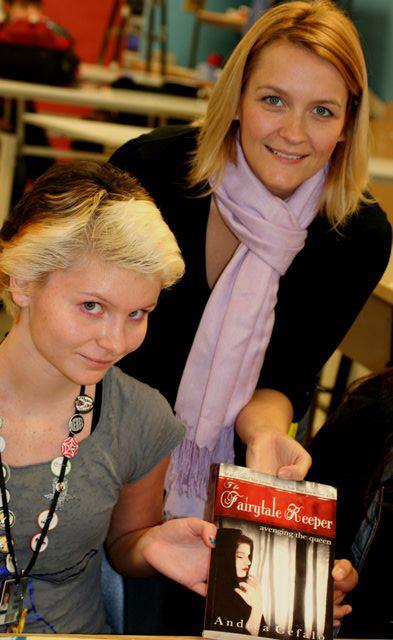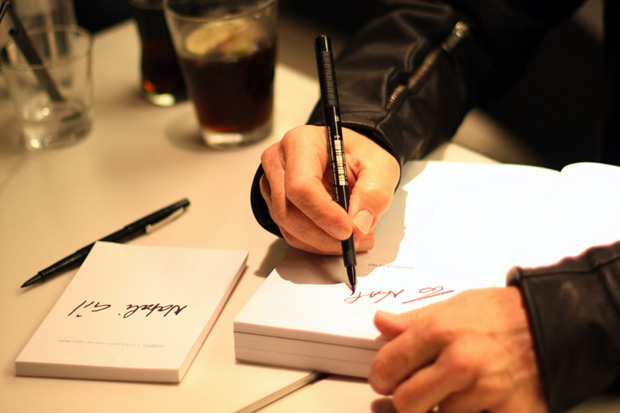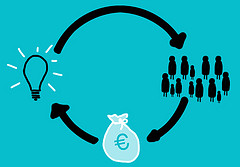Whether already published or merely considering publishing, one of the most daunting tasks for new authors is coming up with the funds to help a book succeed. When I published my first novel, The Fairytale Keeper, I was told that indie authors should save $5000 to help fund their project. That’s a gross underestimate. Sadly, indie authors need much more than that to be successful, but, the good news is that getting other people to fund these creative ventures is easier than ever.
The Hefty Cost of Self-Publishing
1. Editing: Bargain-$2100 Splurge-$4,000
Professional revising and editing is a must have because no matter how amazing the content, sloppy writing will result in bad reviews. Keep in mind that most editors charge by the word or page, so the longer your book, the more money it will cost. Just as an example, editing and proofing for a 75,000 word novel, would cost $2100.
2. Cover Art: Bargain-$200 Splurge -$2000
 They say don’t judge a book by its cover, but everyone does. One could argue that the outside of a book is just as important as the inside because if the cover is unappealing, no one is going to bother picking up the book to find out what’s on the inside. On average, publishing houses spend between $500 and $1200 for cover art, but a bargain-hunter can find a decent cover artist for $200.
They say don’t judge a book by its cover, but everyone does. One could argue that the outside of a book is just as important as the inside because if the cover is unappealing, no one is going to bother picking up the book to find out what’s on the inside. On average, publishing houses spend between $500 and $1200 for cover art, but a bargain-hunter can find a decent cover artist for $200.3. Formatting: Bargain-Free Splurge-$500
Formatting is when an author goes from a 75,000 word file to a polished paperback or ebook. Different ebook retailers require different formats, making this a very complicated, time-consuming process. However, there are oodles of great formatting tutorials on YouTube, and a thrifty author with plenty of time on his hands can format an ebook and paperback himself, or he can hire a professional. Once again, formatting is like cover art. A professional product is key. If you don’t think you can produce one, you’ll have to pay someone else. On average, formatting is about $250.
4. Copyright, Barcodes, ISBN’s: $315
 It’s always good to get a copyright so your work isn’t stolen. I paid $40 for mine. ISBNs are another necessity. They are like social security numbers for books. I recommend having an ISBN for the ebook and the paperback, although not all retailers require it. Bowker charges $120 for one ISBN or $250 for ten. Most authors publish more than one book, so it makes sense to go ahead and buy ten ISBNs. Paperback and hardback versions require barcodes so that retail stores can scan and sell them. Barcodes are also available through Bowker for $25 each.
It’s always good to get a copyright so your work isn’t stolen. I paid $40 for mine. ISBNs are another necessity. They are like social security numbers for books. I recommend having an ISBN for the ebook and the paperback, although not all retailers require it. Bowker charges $120 for one ISBN or $250 for ten. Most authors publish more than one book, so it makes sense to go ahead and buy ten ISBNs. Paperback and hardback versions require barcodes so that retail stores can scan and sell them. Barcodes are also available through Bowker for $25 each.5. Getting Reviews: Bargain-$700 Splurge-$3100 (approximately)
 This is where it gets tricky to give an estimate. Some indie authors pay for professional reviews. Kirkus Indie will provide an honest review of your book for $425. Some enroll in Publisher’s Weekly Select for $125. This gives them a 25% chance at getting a Publisher’s Weekly review. Some authors turn to NetGalley, which allows teachers, librarians, and reviewers to download upcoming ebooks for free in the hopes that downloaders will actually write a review. NetGalley charges $400 for this service. Keep in mind there are no guarantees on how many people will download or review a book on Netgalley.
This is where it gets tricky to give an estimate. Some indie authors pay for professional reviews. Kirkus Indie will provide an honest review of your book for $425. Some enroll in Publisher’s Weekly Select for $125. This gives them a 25% chance at getting a Publisher’s Weekly review. Some authors turn to NetGalley, which allows teachers, librarians, and reviewers to download upcoming ebooks for free in the hopes that downloaders will actually write a review. NetGalley charges $400 for this service. Keep in mind there are no guarantees on how many people will download or review a book on Netgalley.I didn’t do any of those. I looked up historical fiction, young adult, and indie book bloggers, and I asked them to review my book. I probably sent out hundreds of emails and only heard from about ten percent of the people I wrote, but I ended up on twenty blogs and got about ten reviews, which is about how many a person will end up with when they schedule a blog tour.
Scheduling a blog tour is much easier than emailing three hundred people, and they aren’t too expensive. They cost anywhere between $199 and $700. If you have lots of money to spend, you can hire multiple companies to get on more sites. Bubblecow.net lists a few blog tour companies for indie authors.
6. Establishing an Online Presence: Bargain-$350 Splurge-$6,000
 When people type in my name, I pop up. This is good. Very good. I recommend having a website and blogging about topics that would interest your readers. WordPress.com offers free websites and is user-friendly. For $25, WordPress offers a customized URL, so rather than having a website that says www.andreacefalo.wordpress.com, it will say www.andreacefalo.com. There are lots of online tutorials on how to customize WordPress sites. Check out my site to see how great a WordPress site can look.
When people type in my name, I pop up. This is good. Very good. I recommend having a website and blogging about topics that would interest your readers. WordPress.com offers free websites and is user-friendly. For $25, WordPress offers a customized URL, so rather than having a website that says www.andreacefalo.wordpress.com, it will say www.andreacefalo.com. There are lots of online tutorials on how to customize WordPress sites. Check out my site to see how great a WordPress site can look.Some people don’t want to take the time learning how to design a website. There are plenty of companies that host sites and many web designers out there. Sadly, most of them aren’t cheap.
On average, people spend $5000 for a website. For that price, an author might want to stick with social media to direct readers to their books and ditch the idea of having a website.
Now, it’s time to establish a social media presence. Get on Twitter, Facebook, YouTube, Google+, Goodreads, Pinterest, and LibraryThing (to name a few). The good news about these is that they’re free. Finally, something is free! Providing regular content that appeals to your readers will help your audience grow. Offering to write blog posts for other authors in your genre and book bloggers is another free way to send traffic your way.
Another advantage of Facebook and Twitter is their low-cost, customizable advertising. I recommend running ads to direct people to your Facebook page. I spent about $100 to get 500 Facebook fans. You can also do book giveaways and ads on Goodreads to build an audience there. In total, I probably spent $200 on Goodreads.
7. The Launch: Bargain-$1000 Splurge- $30,000
 Marketing plans, publicists, and PR, oh my! If you’re into DIY, then read up on how to have a successful launch. It will take months to prepare for. I highly recommend starting off by reading The Complete Guide to Self-Publishing by Tom and Marilyn Ross, but there are a number of books and blogs devoted to this topic. At the very least, set up a blog tour, send out a press release, set up book signings, get blog interviews, and let fans on all of your social media sites know when your book is coming out. That’s the short list, folks. The sky is the limit on how much time and money could be spent here. If you want TV/radio interviews, and a nationwide book tour, plan on parting with some serious dough.
Marketing plans, publicists, and PR, oh my! If you’re into DIY, then read up on how to have a successful launch. It will take months to prepare for. I highly recommend starting off by reading The Complete Guide to Self-Publishing by Tom and Marilyn Ross, but there are a number of books and blogs devoted to this topic. At the very least, set up a blog tour, send out a press release, set up book signings, get blog interviews, and let fans on all of your social media sites know when your book is coming out. That’s the short list, folks. The sky is the limit on how much time and money could be spent here. If you want TV/radio interviews, and a nationwide book tour, plan on parting with some serious dough.At the very least, an indie author is going to part with $5000 to launch one book, but an author with access to a lot of money can spend over $45,000. The sweet spot is probably somewhere between those two numbers. Based on what I know now and what I’ve read, I would say somewhere between $15,000 and $30,000 would suffice.
Now here comes the good part!
Getting Other People to Fund Your Project With Crowdfunding
 Crowdfunding is when projects or ventures get funding via the internet by getting large amounts of people to donate small amounts of money. Sites like Indiegogo.com and Kickstarter.com allow regular people to submit a project, ask for a set amount of funds, set up rewards for their donors, and watch the money roll in.
Crowdfunding is when projects or ventures get funding via the internet by getting large amounts of people to donate small amounts of money. Sites like Indiegogo.com and Kickstarter.com allow regular people to submit a project, ask for a set amount of funds, set up rewards for their donors, and watch the money roll in.It’s not as easy as it sounds. Artists only receive money from Kickstarter if they reach their goal. Let’s say someone asks for $10,000, but they only get $9,000 from donors. That would mean their project didn’t get fully funded, and they wouldn’t get any of the money. Instead, the money would be returned to donors. Also, Kickstarter does not allow people to ask for money for marketing plans. Indiegogo works a little differently than Kickstarter. They offer a flex fund payment so innovators don’t have to reach their full funding amount in order to get the money donated to their project. But the competition on Indiegogo is steep because creative projects are up against non-profits.
 Needless to say, if you go with Kickstarter, it’s very important to make sure you get funding. I’m using Kickstarter. It has great tutorials guiding their Kickstarters on how to create a profile that will get them funded. Essentially, an honest story, a creative project, desirable rewards, and an entertaining video result in funding.
Needless to say, if you go with Kickstarter, it’s very important to make sure you get funding. I’m using Kickstarter. It has great tutorials guiding their Kickstarters on how to create a profile that will get them funded. Essentially, an honest story, a creative project, desirable rewards, and an entertaining video result in funding.The more money a person asks for, the harder they are going to have to work to get funded. According to 99u, movie producer Ryan Koo spent an average of eight hours a day for six weeks trying to get people to visit his Kickstarter profile and fund his $125,000 project. His hard work paid off, and his film was fully funded.
I recommend reading 99u’s article on funding a Kickstarter project. Also, view the videos and read the tutorials at Kickstarter. Look through the successful crowdfunding proposals. If you want to see a winning Kickstarter proposal, check out mine at http://www.kickstarter.com/projects/830974252/the-fairest-of-all-book-two-in-the-fairytale-keepe Then, donate to a project that interests you and ask that author to check out yours. Maybe she’ll even share it with her friends, and you’ll get more funding for your project.

Andrea Cefalo is a blogger on the Middle Ages and Indie-Publishing, as well as the award-winning author of The Fairytale Keeper series. The Fairytale Keeper, the first in The Fairytale Keeper series, is a medieval novel of corruption, devotion, and the origins of Grimm’s fairy tales. The second novel in the series, The Fairest of All, will debut early 2014.
Andrea resides in Greenville, South Carolina with her husband and their two border collies. If you want to see a winning crowdfunding project, check hers at http://www.kickstarter.com/projects/830974252/the-fairest-of-all-book-two-in-the-fairytale-keepe
